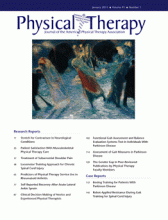Recovery of function after spinal cord injury (SCI) depends on a complex interaction between severity of injury and the type and intensity of training. The paradigm shift toward activity-dependent neurorehabilitation makes it important to identify the critical training features that promote locomotor recovery. Field-Fote and Roach1 completed an ambitious randomized clinical trial to determine which of 4 types of activity-based training for locomotion produced important gains in gait speed and distance after chronic incomplete SCI. The 4 paradigms all provided body-weight support, which is well-justified, given evidence from experimental and human SCI studies that some unweighting optimizes muscle activation and stepping kinematics.2–5 The 4 training groups were: treadmill training with manual assistance (TM), treadmill training with stimulation of flexor reflex afferents (TS), robotic treadmill training (LR), and overground walking with stimulation and an assistive device (OG).
The scientific rationale for each of the paradigms appears to depend on using manual assistance, electrical stimulation, or robotics to drive motor learning and, ultimately, to improve overground locomotion. Effective motor learning depends on multiple factors such as trial and error during practice, specificity of training, intensity and scheduling of practice, and type of practice environment.6 These important motor learning parameters varied widely across groups. For instance, 3 groups trained in a novel environment (ie, on the treadmill), and 1 group participated in task-specific training (ie, overground locomotion). In addition, 2 groups (TM, OG) experienced variable practice with trial and error from step-to-step, whereas 2 groups had …












